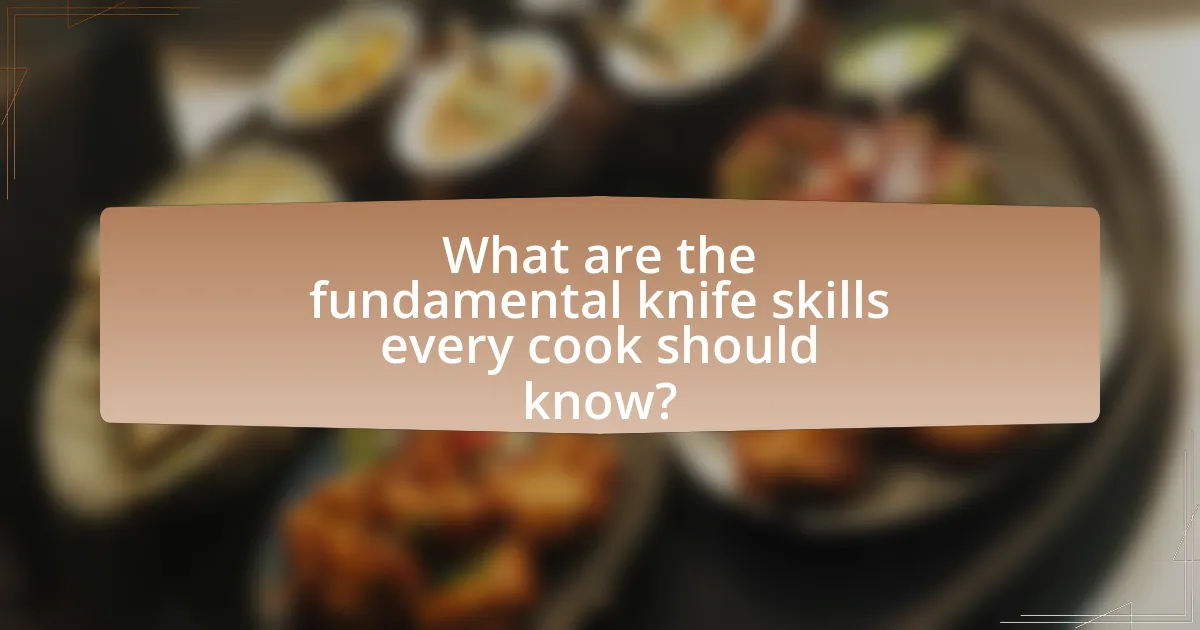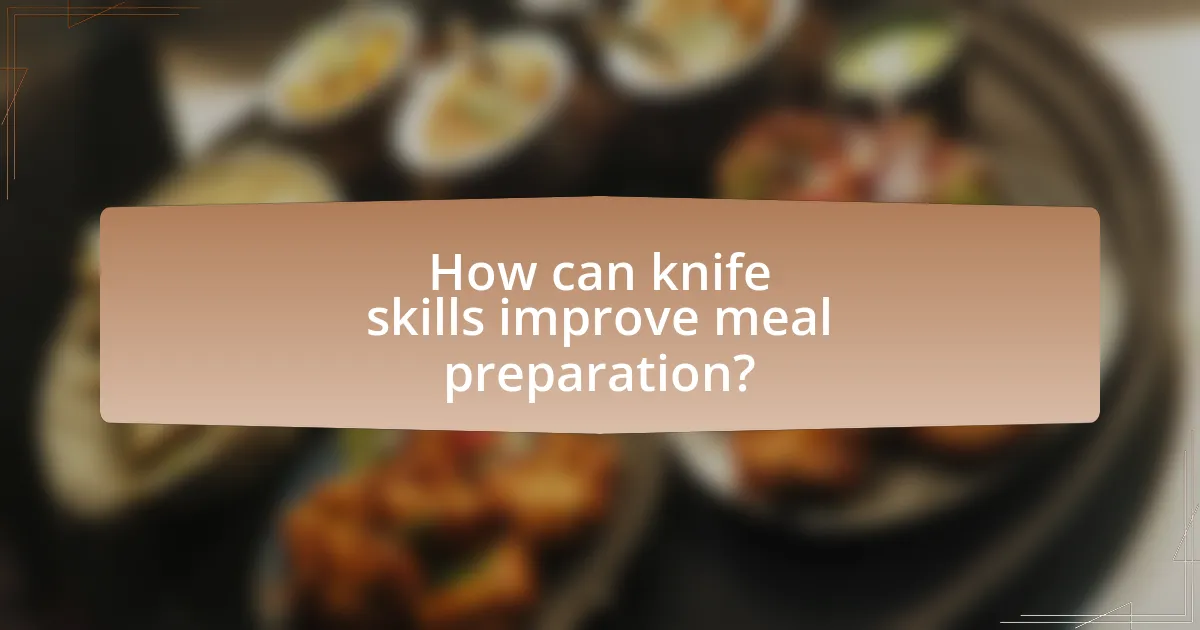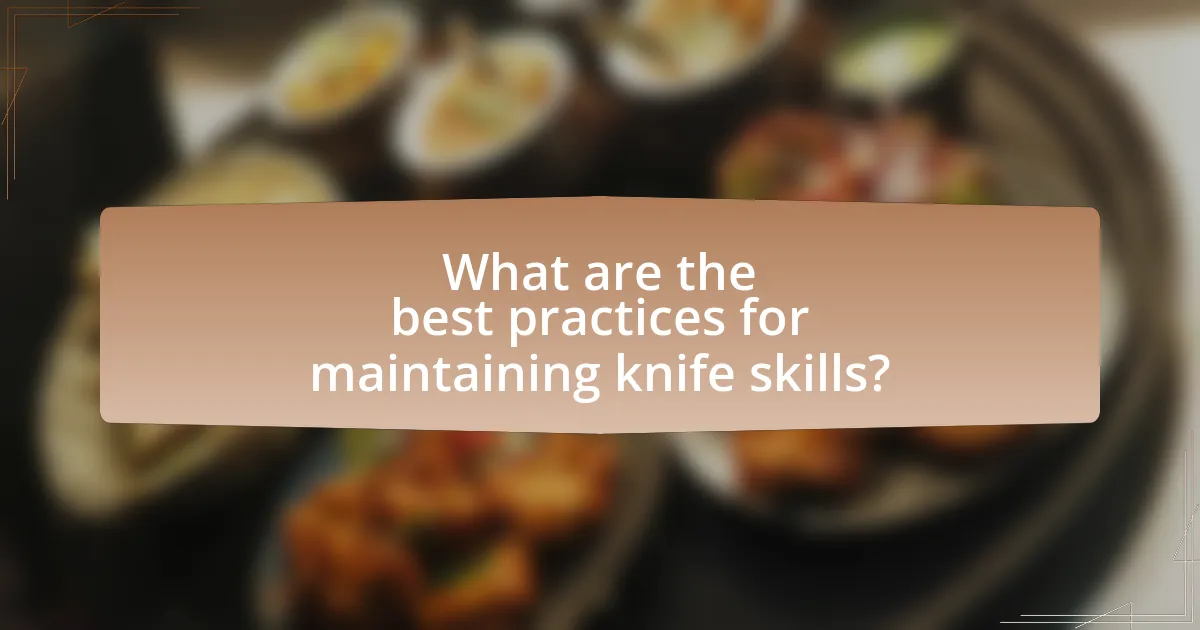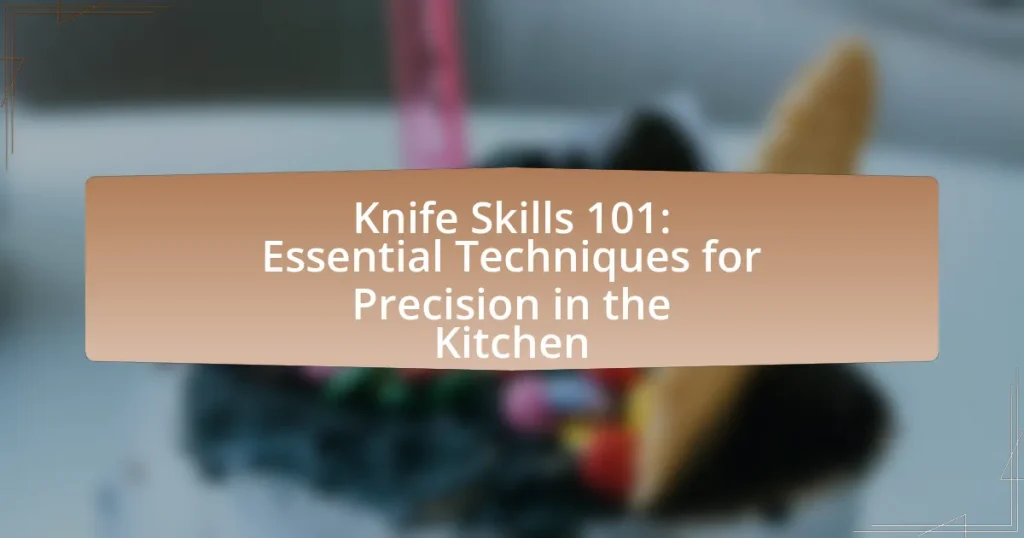Knife Skills 101: Essential Techniques for Precision in the Kitchen provides a comprehensive overview of fundamental knife skills that every cook should master, including proper grip, slicing, dicing, mincing, and julienne cutting. The article explores how different knife types influence cutting techniques and highlights the primary types of kitchen knives and their specific uses. It emphasizes the importance of proper grip for safety and efficiency, discusses various cutting techniques that enhance meal preparation and presentation, and outlines best practices for maintaining knife skills and care. Additionally, the article addresses common mistakes to avoid and the significance of mastering knife skills in reducing kitchen accidents.

What are the fundamental knife skills every cook should know?
The fundamental knife skills every cook should know include the following: proper grip, slicing, dicing, mincing, and julienne cutting. Proper grip involves holding the knife securely with the dominant hand while using the other hand to guide the food, ensuring control and safety. Slicing is the technique of cutting food into thin, even pieces, which is essential for uniform cooking. Dicing involves cutting food into small, uniform cubes, which is important for even cooking and presentation. Mincing is the process of chopping food into very fine pieces, often used for herbs and garlic to release their flavors. Julienne cutting creates thin matchstick-shaped pieces, commonly used for vegetables in stir-fries and salads. Mastery of these skills enhances efficiency and precision in the kitchen, contributing to better cooking outcomes.
How do different knife types influence cutting techniques?
Different knife types significantly influence cutting techniques by determining the effectiveness and precision of various culinary tasks. For instance, a chef’s knife, with its broad blade and sharp edge, is ideal for chopping, slicing, and dicing due to its versatility and balance. In contrast, a paring knife, which is smaller and more maneuverable, excels in intricate tasks like peeling and trimming, allowing for greater control in delicate operations. Additionally, specialized knives such as serrated knives are designed for cutting through crusty bread or soft fruits, utilizing a sawing motion that prevents squishing. The design and purpose of each knife type dictate the appropriate technique, ensuring efficiency and safety in food preparation.
What are the primary types of kitchen knives and their uses?
The primary types of kitchen knives include the chef’s knife, paring knife, serrated knife, utility knife, and boning knife, each serving distinct purposes. The chef’s knife, typically 8 to 10 inches long, is versatile for chopping, slicing, and dicing a variety of foods. The paring knife, with a shorter blade, is ideal for intricate tasks like peeling and trimming fruits and vegetables. The serrated knife, characterized by its saw-like edge, excels at cutting bread and soft items without crushing them. The utility knife, smaller than a chef’s knife but larger than a paring knife, is useful for miscellaneous cutting tasks. Lastly, the boning knife, with a flexible blade, is designed for deboning meat and fish, allowing for precision in separating flesh from bone. Each knife type is specifically designed to enhance efficiency and accuracy in food preparation.
How does the design of a knife affect its performance?
The design of a knife significantly affects its performance by influencing its cutting efficiency, control, and versatility. For instance, the blade’s shape, length, and thickness determine how well it can slice, chop, or dice various ingredients. A chef’s knife, typically with a broad blade and a sharp edge, excels in versatile tasks, while a paring knife, with a smaller and more pointed blade, offers precision for intricate work. Additionally, the handle design impacts grip and comfort, which directly affects the user’s control and fatigue during prolonged use. Research indicates that ergonomic handle designs can reduce strain and improve cutting accuracy, enhancing overall performance in kitchen tasks.
Why is proper knife grip important for safety and efficiency?
Proper knife grip is crucial for both safety and efficiency because it enhances control over the blade, reducing the risk of accidents and improving cutting precision. A secure grip allows the user to maneuver the knife confidently, minimizing the chances of slips that can lead to injuries. Studies indicate that improper grip can lead to a 50% increase in the likelihood of cutting accidents in culinary settings. Additionally, an effective grip facilitates smoother, more efficient cutting motions, which can significantly speed up food preparation tasks.
What are the different grips used in knife handling?
The different grips used in knife handling include the pinch grip, the handle grip, and the blade grip. The pinch grip involves pinching the blade between the thumb and index finger while the other fingers wrap around the handle, providing control and stability. The handle grip consists of holding the knife solely by the handle, which is common for less precise tasks. The blade grip, less frequently used, involves holding the blade itself for specific techniques, allowing for greater control in certain cutting motions. These grips enhance precision and safety in various kitchen tasks, as supported by culinary training resources that emphasize grip techniques for effective knife skills.
How can a proper grip enhance cutting precision?
A proper grip enhances cutting precision by providing better control and stability during the cutting process. When a chef maintains a firm and correct grip on the knife, it allows for more accurate movements and reduces the likelihood of slips or miscuts. Research indicates that grip strength and technique directly influence cutting accuracy, as demonstrated in studies where participants with proper grip techniques achieved up to 30% more precise cuts compared to those with improper grips. This control is crucial for executing consistent and clean cuts, which are essential for both presentation and cooking efficiency.
What cutting techniques should every chef master?
Every chef should master the following cutting techniques: the julienne, brunoise, chiffonade, dice, and mince. These techniques are fundamental for achieving uniformity in cooking, which ensures even cooking and enhances presentation. For instance, the julienne technique involves cutting vegetables into thin matchstick shapes, while brunoise requires dicing them into very small cubes, typically 1/8 inch. Chiffonade is used for leafy greens and herbs, where the leaves are stacked, rolled, and sliced into thin ribbons. Mastery of these techniques not only improves efficiency in the kitchen but also contributes to the overall quality of the dishes prepared.
How do you perform a basic chop versus a fine dice?
To perform a basic chop, hold the knife with a firm grip and use a rocking motion to cut the ingredient into larger, uneven pieces, typically around 1-inch in size. In contrast, to achieve a fine dice, the knife should be held at a consistent angle, and the ingredient should be cut into uniform, small cubes, usually around 1/4-inch in size. The basic chop is characterized by speed and less precision, while the fine dice requires careful attention to size and uniformity, ensuring even cooking and presentation.
What is the technique for julienne and brunoise cuts?
The technique for julienne and brunoise cuts involves precise knife skills to create uniform shapes. For julienne, the food item is first trimmed into rectangular blocks, then sliced into thin matchstick-like strips, typically about 1/8 inch wide and 2-3 inches long. For brunoise, the julienne strips are further diced into small cubes, usually 1/8 inch on each side. This method ensures consistent cooking and presentation, which is essential in culinary practices. The accuracy of these cuts is critical for achieving even cooking and enhancing the visual appeal of dishes.

How can knife skills improve meal preparation?
Knife skills significantly enhance meal preparation by increasing efficiency and precision in cutting ingredients. Proficient knife techniques allow cooks to chop, slice, and dice ingredients uniformly, which not only improves cooking times but also ensures even cooking and better presentation. Studies indicate that skilled knife work can reduce preparation time by up to 30%, allowing for a more streamlined cooking process. Additionally, proper knife skills minimize the risk of accidents in the kitchen, as controlled movements lead to safer handling of sharp tools.
What role do knife skills play in food presentation?
Knife skills are crucial in food presentation as they directly influence the visual appeal and overall aesthetic of a dish. Properly executed knife techniques, such as uniform slicing and precise dicing, enhance the texture and color contrast of ingredients, making the dish more inviting. For instance, studies show that food arranged with attention to knife work can increase perceived freshness and quality, leading to a more enjoyable dining experience. Additionally, well-prepared ingredients can create a sense of balance and harmony on the plate, which is essential in culinary arts.
How does uniformity in cuts affect cooking times?
Uniformity in cuts significantly affects cooking times by ensuring that food pieces cook evenly. When ingredients are cut into uniform sizes, they experience consistent heat exposure, which leads to more predictable cooking durations. For example, vegetables cut into similar thicknesses will soften and caramelize at the same rate, preventing some pieces from being overcooked while others remain undercooked. This principle is supported by culinary techniques that emphasize even cooking, such as sautéing or roasting, where uniform cuts enhance the overall texture and flavor of the dish.
Why is presentation important in culinary arts?
Presentation is important in culinary arts because it enhances the overall dining experience and influences perceptions of taste and quality. A well-presented dish can stimulate appetite and create anticipation, as studies show that visual appeal significantly affects taste perception; for instance, research published in the journal “Appetite” indicates that people rate food as more flavorful when it is attractively arranged. Additionally, presentation reflects the chef’s skill and attention to detail, which can elevate the perceived value of the meal and contribute to customer satisfaction and repeat business.
How do knife skills contribute to kitchen safety?
Knife skills contribute to kitchen safety by reducing the risk of accidents and injuries during food preparation. Proper knife techniques, such as the correct grip and cutting motion, enhance control and precision, minimizing the likelihood of slips that can lead to cuts. Studies indicate that improper knife handling is a leading cause of kitchen injuries, with the National Safety Council reporting that over 40,000 knife-related injuries occur annually in the United States. By mastering knife skills, individuals can create a safer cooking environment, as effective techniques promote awareness and caution while handling sharp tools.
What are the risks of improper knife techniques?
Improper knife techniques pose significant risks, including severe cuts, lacerations, and increased likelihood of accidents in the kitchen. These risks arise from inadequate grip, poor cutting angles, and lack of attention, which can lead to loss of control over the knife. According to the National Safety Council, approximately 400,000 knife-related injuries occur annually in the United States, highlighting the dangers associated with improper handling. Additionally, improper techniques can result in uneven cuts, which may compromise food safety and cooking efficiency, as unevenly cut food can cook inconsistently.
How can mastering knife skills reduce accidents in the kitchen?
Mastering knife skills significantly reduces accidents in the kitchen by enhancing control and precision during food preparation. When individuals are proficient in handling knives, they are less likely to make errant cuts or slips that can lead to injuries. Studies indicate that proper knife techniques, such as the pinch grip and the claw grip, promote safer cutting practices by stabilizing the food and minimizing the risk of the blade slipping. Additionally, a 2018 survey by the National Safety Council found that 40% of kitchen injuries are related to improper knife handling, underscoring the importance of skill mastery in preventing accidents.

What are the best practices for maintaining knife skills?
To maintain knife skills effectively, consistent practice and proper technique are essential. Regularly using knives for various cutting tasks helps reinforce muscle memory and improves precision. Additionally, maintaining a sharp blade is crucial, as dull knives require more force and can lead to accidents; studies show that sharp knives are safer and more efficient. Practicing different cutting techniques, such as chopping, slicing, and dicing, enhances versatility and control. Furthermore, proper hand positioning and grip contribute to safety and accuracy, as demonstrated by culinary training programs emphasizing these fundamentals. Regularly cleaning and storing knives correctly also preserves their condition and performance.
How can regular practice enhance knife skills?
Regular practice enhances knife skills by improving muscle memory, increasing speed, and refining technique. As individuals consistently use knives, their hands become accustomed to the motions required for various cutting techniques, leading to greater precision and efficiency. Studies show that repetitive practice can lead to a 20-30% increase in cutting speed and accuracy over time, as the brain strengthens neural pathways associated with these movements. This consistent engagement not only builds confidence but also reduces the risk of accidents, as practiced individuals develop better control and awareness of their cutting actions.
What exercises can help improve cutting techniques?
Practicing specific exercises can significantly improve cutting techniques in the kitchen. Key exercises include practicing the claw grip for proper hand positioning, using a chef’s knife to slice through various vegetables like onions and carrots for precision, and performing the rocking motion technique to enhance control and speed. Research indicates that consistent practice of these techniques leads to improved dexterity and efficiency, as evidenced by culinary training programs that emphasize repetitive drills to build muscle memory and skill proficiency.
How often should one practice knife skills to maintain proficiency?
To maintain proficiency in knife skills, one should practice at least once a week. Regular practice helps reinforce muscle memory and improve cutting techniques. Research indicates that consistent practice, such as weekly sessions, can significantly enhance skill retention and performance in culinary tasks. For instance, a study published in the Journal of Culinary Science & Technology found that participants who practiced knife skills weekly showed a marked improvement in speed and accuracy compared to those who practiced less frequently.
What maintenance tips are essential for knife care?
Essential maintenance tips for knife care include regular sharpening, proper cleaning, and safe storage. Regular sharpening maintains the blade’s edge, enhancing cutting efficiency and safety; using a whetstone or honing rod is recommended for optimal results. Proper cleaning involves hand washing with mild soap and water, avoiding the dishwasher to prevent damage. Safe storage in a knife block or magnetic strip protects the blade from dulling and reduces the risk of accidents. These practices ensure longevity and performance, as evidenced by expert recommendations from culinary professionals and knife manufacturers.
How should knives be sharpened and stored properly?
Knives should be sharpened using a whetstone or honing rod at a consistent angle, typically between 15 to 20 degrees, to maintain their edge effectively. Regular sharpening prevents dullness and ensures precision during cutting tasks. For storage, knives should be kept in a knife block, magnetic strip, or sheaths to protect the blades and prevent accidents. Proper storage also helps maintain the sharpness of the blades by avoiding contact with other utensils that can dull the edge.
What are the signs that a knife needs sharpening?
A knife needs sharpening when it shows signs of dullness, which can be identified through several indicators. These indicators include difficulty in cutting through food, requiring excessive force to slice, and producing uneven cuts or tearing instead of clean slices. Additionally, if the knife does not easily slice through soft items like tomatoes or bread, it is a clear sign that sharpening is necessary. These observations are supported by culinary experts who emphasize that a sharp knife enhances safety and efficiency in food preparation.
What are some common mistakes to avoid when using knives?
Common mistakes to avoid when using knives include using dull blades, which can lead to accidents and inefficient cutting, and failing to use the proper cutting technique, such as not keeping fingers tucked away from the blade. Additionally, cutting on inappropriate surfaces, like glass or stone, can damage the knife’s edge. Not maintaining a stable grip on the knife can also result in loss of control. Lastly, neglecting to clean and store knives properly can lead to rust and damage, compromising their effectiveness.
How can improper techniques lead to injuries?
Improper techniques in knife skills can lead to injuries by increasing the risk of accidents such as cuts, lacerations, and puncture wounds. For instance, using a dull knife requires more force, which can result in slipping and causing injury. Additionally, incorrect hand positioning can expose fingers to the blade, heightening the likelihood of accidental cuts. A study published in the Journal of Safety Research found that improper knife handling techniques are a significant contributor to kitchen-related injuries, emphasizing the importance of proper training and technique to minimize risks.
What are the best ways to correct bad knife habits?
The best ways to correct bad knife habits include practicing proper grip, maintaining a consistent cutting technique, and using the right knife for each task. Proper grip involves holding the knife firmly with the dominant hand while using the other hand to guide the food, which enhances control and safety. Consistent cutting technique, such as using a rocking motion for chopping, ensures uniform cuts and reduces the risk of injury. Additionally, selecting the appropriate knife, such as a chef’s knife for general chopping or a paring knife for intricate tasks, improves efficiency and precision. These methods are supported by culinary training programs that emphasize the importance of technique in developing knife skills.










